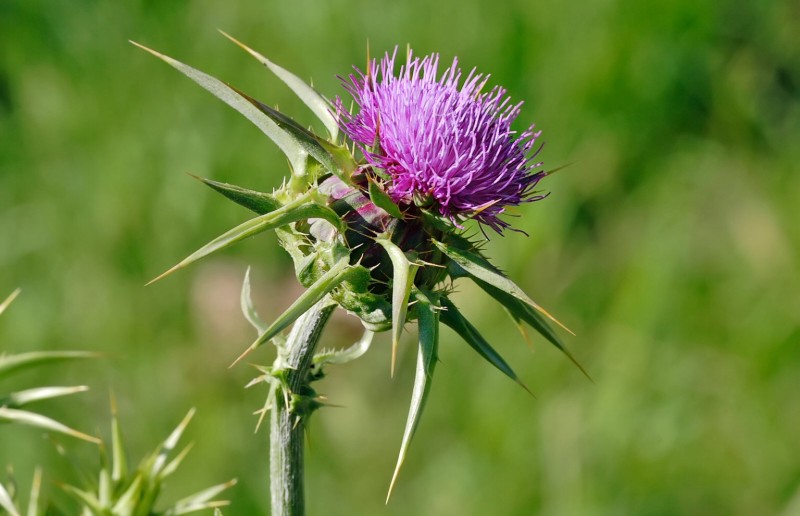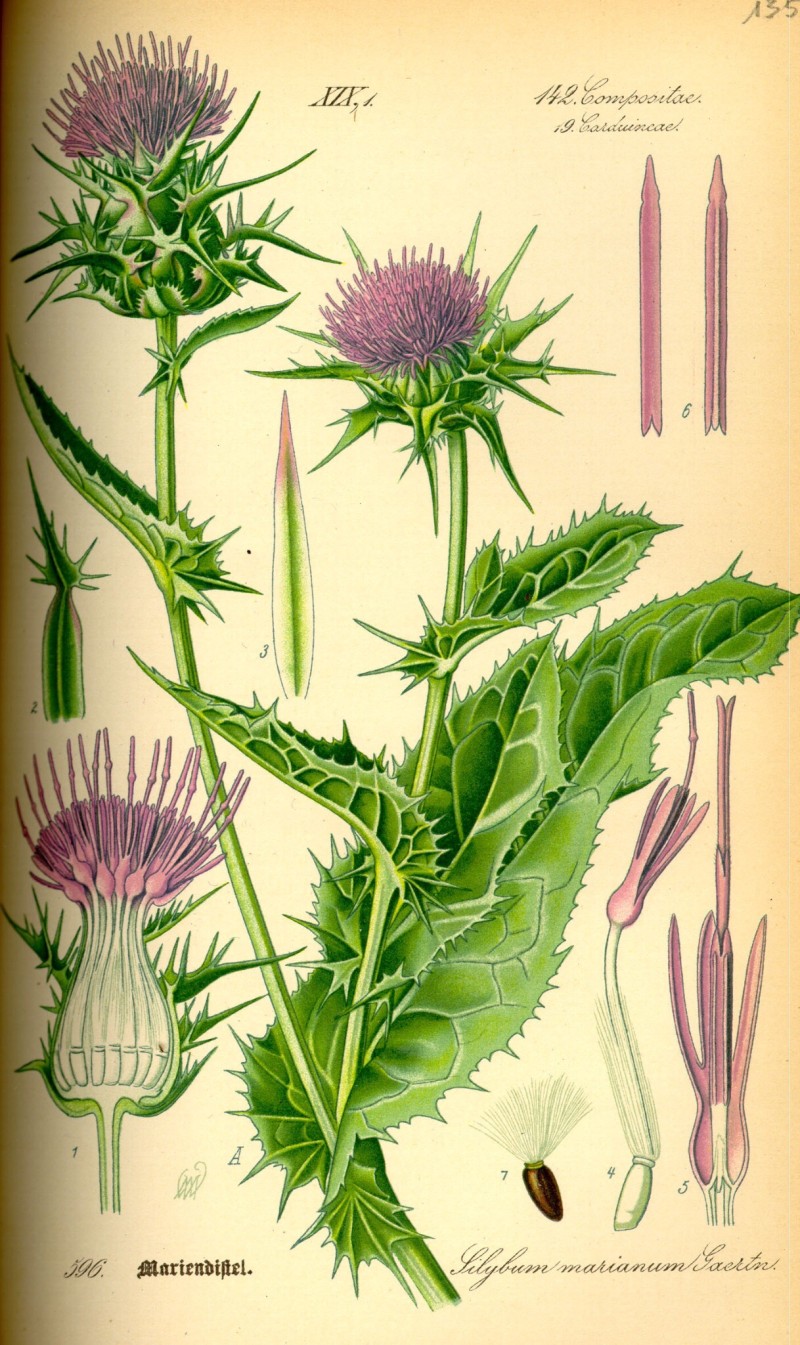Milk Thistle (Silybum marianum) has been over the past few millennia, at the very least, one of the most widely used and effective herbs in the world. It’s probably the most important herbal liver medicine out there — and can be used very effectively to help limit/prevent liver damage when exposed to toxins/poisons.
Isolated compounds from the milk thistle plant (Silymarin, Silibinin) are commonly used as treatment for: some types of mushroom poisoning; cerebral edema (a type of brain swelling); acute hepatitis; and other types liver disease/damage and/or toxin exposure.
And it’s worth noting up front that milk thistle (via extract) is itself an effective (not perfectly so, but to a notable degree) remedy against severe liver damage or death in the case of the ingestion of some types of poisonous mushrooms (such as death caps).
Background and General Information On The Milk Thistle Plant (Silybum marianum)
Milk thistle — also commonly known by the names of Scotch thistle, cardus marianus, Marian thistle, Mary thistle, Saint Mary’s thistle — is an annual or biennial plant species classified as being in the Asteraceae family.
The plant is thought to have probably originally been native to Southern Europe and Western Asia, but is now found as a “weed” practically anywhere in the world — owing to its hardiness and aggressive reproductive strategies.
It’s quite easy to recognize — with distinctive purple or red flowers; and shiny, spiny leaves decorated with milk white veins. Milk thistle plants typically grow to be 1-7 feet in height, but can actually get larger than that in some circumstances. As the plant gets taller the stem tends to hollow out.
The plant tends to flower in the early to late summer — in the Northern Hemisphere, typically between the months of June and August.
Milk thistles are currently cultivated in large numbers in many countries of the world — for use by the pharmaceutical industry — including: Austria, Poland, Germany, Hungary, China, and Argentina. The plant is typically harvested 2 to 3 weeks after flowering — via a two-step process: cutting and threshing.
Chemistry Of Milk Thistles & Research Findings
The seeds of milk thistles have been used for many thousands of years (at the very least) as a liver medicine. When considering the plant from a modern scientific mindset, much of its efficacy derives from the compound sylimarin — as well as related compounds.
Traditionally, milk thistle extract was made from these seeds (which contain ~4-6% silymarin) — resulting in an extract consisting of around 65–80% silymarin (a flavonolignan complex) plus 20–35% various fatty acids (linoleic acid, etc).
Silymarin is a complex mixture of polyphenolic molecules, including seven closely related flavonolignans (silybin A, silybin B, isosilybin A, isosilybin B, silychristin, isosilychristin, silydianin) and one flavonoid (taxifolin). Silibinin, a semipurified fraction of silymarin, is primarily a mixture of 2 diastereoisomers, silybin A and silybin B, in a roughly 1: 1 ratio.
Compounds found in milk thistle have been shown by research to have action against liver disease and some types of cancer.
Here are some of the key research findings concerning milk thistle over recent years:
- Clinical research has found that milk thistle extracts can work to both prevent and repair liver damage caused by workplace exposure to toluene and/or xylene. Workers exposed to vapors from those toxic chemicals for 5-20 years were randomly given one of either: a standardized milk thistle extract (80% silymarin), or a placebo; for a period of 30 days. The workers that had been given the milk thistle extract showed significant improvement in liver function tests (ALT and AST) and platelet counts as compared against the placebo group.
- Clinical trials have also found that silymarin administered in doses of 600 mg a day was a very effective treatment option for type II diabetes
- Animals studies have, in keeping with herbal knowledge, demonstrated that Silibinin (silybin, sylimarin I) has hepatoprotective (antihepatotoxic) properties — protecting liver cells against the effects of toxins.
- A recent study done with baboons (hmm….) found that continuous intragastric infusion of silymarin significantly retarded the development of alcohol-induced hepatic fibrosis over a 3-year period.
- A 2010 study published in the journal Cancer found that milk thistle was associated with a trend towards reduced liver damage in children receiving chemotherapy — during a randomized double-blind placebo controlled study of 50 children.
- “The efficacy of silymarin in preventing drug-induced liver damage in patients taking psychotropic drugs long-term has been investigated and silymarin was found to reduce damage to the liver caused by lipid peroxidation in patients taking butyrophenones or phenothiazines.”
- “A study in 2010 found that eight major compounds that comprise silybum, including seven flavonolignans — silybin A, silybin B, isosilybin A, isosilybin B, silychristin, isosilychristin, silydianin, and one flavonoid, taxifolin — are inhibitors of HCV RNA-dependent RNA polymerase, suggesting potential in treating Hepatitis C.”
- Silibinin is an effective treatment following poisoning by amanitas mushrooms, including the Death Cap (Amanita phalloides).
- Silybum marianum extract (milk thistle) possesses notable antifungal effects — particularly with regard to preventing the growth of dermatophyte fungi.
- Some preliminary research has suggested that milk thistle may be as effective as the common medication fluoxetine in the treatment of obsessive-compulsive disorder.
Other possible medicinal effects, yet to be confirmed satisfactorily by scientific research, include: reducing cellular damage caused by radiation and chemotherapy treatments; lowering “bad” cholesterol levels; reducing insulin resistance; reducing the growth of various cancers (prostate, breast, cervical); and preventing Alzheimer’s Disease.
Herbal Uses Of Milk Thistle & Use In Treatment Of Mushroom Poisoning
Traditionally milk thistle and milk thistle extract have been used to treat liver issues — including liver damage, jaundice, cirrhosis, hepatitis, and poisoning.
Milk thistle has also often been used, as many bitter greens are, as an appetite stimulant — this is probably owing to the fact that bitter foods/flavours stimulate the release of bile, which aids in digestion. Particularly in the digestion of fatty foods.
Milk thistle has also traditionally been used for gallbladder issues, heartburn, spleen issues, malaria, female problems, and allergies.
It’s also apparently been used as a galactagogue (milk production stimulant), and to bring on the onset of menses.
With regard to treating Amanita mushroom poisoning with milk thistles or milk thistles extract here’s the available evidence on that count:
Amanita Phalloides poisoning is relatively rare, and such hard evidence as is available comes from animal studies. The efficacy of thirty different treatments was analyzed in a retrospective study of 205 cases of Amanita phalloides (death cap) mushroom poisoning. Both penicillamine and hyperbaric oxygen independently contributed to a higher rate of survival. When silybin (silibinin) was added to the penicillamine treatment, survival was increased even more. In another 18 cases of death cap poisoning, a correlation was found between the time elapsed before initiation of silybin therapy, and the severity of the poisoning. The data appear to indicate that severe liver damage in Amanita phalloides poisoning can be prevented effectively when administration of silybin begins within 48 hours of mushroom intake. Case control studies also suggest that silibinin reduces mortality from mushroom poisoning.
It’s worth stating outright right here that there is substantial anecdotal evidence for the effectiveness of treating death cap poisoning with milk thistle extract, going back quite some time — that’s not to say that it’s a miracle solution though, death caps are extremely toxic. But the extract clearly has a lot going for it in this regard.
Side Effects Of Milk Thistle
The side effects of milk thistle and milk thistle extract are pretty limited (as far as is known), with the only effects being the occasional report of nausea or diarrhea.
The compounds in milk thistle reportedly may mimic the effects of certain estrogens in the human body — as a result some physicians recommend that women with breast, ovarian, or uterine cancers, not use it. There’s some debate on this matter though — and as noted above, milk thistle extract does appear to show some efficacy against certain types of cancer. So…
Interactions with common prescription medications are known, so those currently taking prescription drugs should probably consult with their physician before beginning self-treatment with milk thistle.
Milk Thistles As Food
Milk thistle is actually rather nutritious as a food item — with the young shoots, roots, and flower heads (think of artichokes), all making for good food.
Traditionally the roots were eaten with butter after being either boiled or roasted, but they can also be eaten raw. The young shoots can be used much as any other vegetable green is — steamed, stewed, etc. The spiny bracts on the flower head were used similarly to the way that artichokes are used commonly nowadays — I haven’t tried that yet myself, so can’t vouch for it.
An option for those that don’t like bitter flavours but who don’t want to “waste” the stems is to soak them overnight and then discard the water before cooking them.
The mature leaves can also be used, though they certainly have a stronger flavor than the young shoots — they make a pretty good spinach substitute, and are quite nutritious. Make sure to remove the sharp bits from the leaves before cooking or eating though. They can be eaten raw.
As always, despite the fact that the plant is itself completely edible, be careful where you forage. While they grow nearly everywhere as weeds, you really don’t want to eat any plants that grow where domesticated animals regularly defecate and/or places sprayed with herbicides, pesticides, etc.
Plants growing alongside busy roads are also something of an issue, as milk thistles tend to take up lead in soil quite readily — so plants growing alongside busy roads are likely to possibly contain high levels of the heavy metal. (Lead was an additive in gasoline in many parts of the world until the 70s/80s; it still is in some parts of the world.)
One last thing — the seeds can apparently be roasted and used as a coffee substitute. I’ve never tried this though, so can’t speak to the taste.
Toxicity To Farm Animals
Something that should be noted here, for those considering growing/encouraging milk thistle, the plant is toxic to some common farm animals — in particular to cattle and sheep. This is owing to the pottasium nitrate content of milk thistle.
When the compound is consumed by ruminants, the microflora living in the stomach and guts of the animals break it down — thereby producing nitrate ions. These nitrate ions then combine with hemoglobin to create methaemoglobin — which blocks the transport of oxygen, leading to health problems.
For information on other common, completely free, but highly useful or nutritious “weeds”, see:
Nettles, Great Tasting, High-Protein Content, Vitamin And Mineral-Rich, And Free
What Is Dandelion? Top Benefits And Uses Of The Dandelion Plant
Image Credits: Public Domain: Creative Commons





